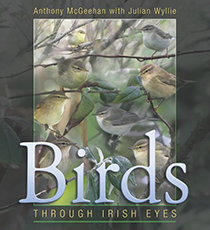Birds Through Irish Eyes by Anthony McGeehan with Julian Wyllie
There are times when a sense of doom and demise makes me wonder if I would have found greater fascination in life if, in childhood, I had taken up astronomy: a universe, for the moment, safe from the ravages of Homo sapiens. Instead I am left to feel the burden of birdlife being lost. But not all. Even in Ireland where few 'get' the natural world, miracles occur. (Anthony McGeehan, p.63).

It's a book aimed at everyone. Besides the species accounts are chapters on the best field guide (Jonson not Svensson, curiously) and choosing binoculars; separating Chiffchaff from Willow Warbler; and, for the more advanced birder, a chapter on moult. With such a broad canvas McGeehan's writing becomes more impressive: he is an engaging author, not patronising or full of jargon. I think special mention needs to be made of an author who can use the word 'eisteddfod' while remaining eminently readable and quotable at length. His style is appropriately anecdotal so his chapter on binoculars is still worth reading even for those who have been happily married to their pair for many years. In the species accounts his literary sensibility sits well with his scientific outlook and together they display the author's deep knowledge and experience of his subject matter. Not many writers can bring a bird to life like McGeehan can.
One of the most enlightening aspects of the book was the historical context it situates birds in: I learnt that Bean Geese used to be the commonest grey goose species on the Solway Firth until the late 19th century, and the links between its Irish and Scottish declines; and that Bewick's Swans used to outnumber Whooper Swans 25 to 1, but barely a handful of the former winter there now. Are we guilty of generally looking at population changes outside of their historical context?
Occasionally McGeehan's writing becomes sardonic, such as: 'overhead, sheep-following crows squawk and peer from sentinel crags, a sight as heart-warming as battery acid in a baby's bottle'. He tackles controversial subjects head on and is to be applauded for having the courage to go deeply off-message on the effects of crows on songbirds and foxes on ground-nesting birds; even when it becomes uncomfortable reading in parts for, in his words, those 'bleeding-heart liberals' (such as myself) who harbour a soft-spot for Magpies. However, his dissenting views aren't developed as a full and fair argument in the limited space of the species accounts. A specific chapter to develop and justify these views properly would've been welcome and become a much more effective critique of the RSPB and what he describes as 'misplaced ethical sympathies' than he manages.
The photos aim at realism over 'unnatural close-up portraits' despite many of them being close-up portraits: the beginner may think Storm-petrels have a tendency to show much better than they actually do. They are generally of an excellent standard, though, and the commitment to realism helps you look afresh at the subjects. We've all seen many Teal, but rarely stop to consider the absurdly good looks of this pocket-sized duck.
The downside to books such as this is that they become out of date almost as soon as they are published, although this is as up to date as to include a passage on the Iceland Gull influx of last winter. Priced at £35 this book is an excellent resource and reference text for the state and context of Irish birds, as well as being an enjoyable and provocative read. Let's hope the next edition can bring better news of Irish birds.
Hardcover, 332pp.
The Collins Press (2012), ISBN 978-1-84889-162_3, RRP: £35.00


